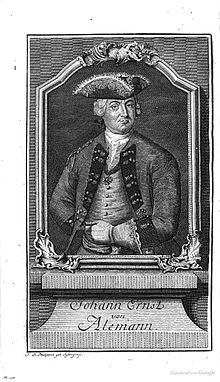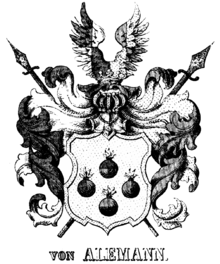Johann Ernst von Alemann
Johann Ernst Alemann , von Alemann since 1731 , (* 1684 in Borgholzhausen ; † June 4, 1757 in Kankelfitz , Western Pomerania ) was a major general and head of a dragoon regiment in the Prussian army .
Life
Johann Ernst Alemann was the eldest son from the second marriage of the royal Prussian domain official Anton Engelhard Alemann, Vogt zu Borgholzhausen . Johann Ernst was supposed to become a businessman, but joined the Prussian Dragoon Regiment I in 1702. With this he took part in the Battle of Oudenaarde in 1708 and in the Battle of Malplaquet in 1709 . During the Great Northern War he was one of the besiegers of Stralsund . In 1717 he was promoted to lieutenant and in 1722 to staff captain and was given his own company , with which he in 1725 when his regiment was dividedcame to the Dragoon Regiment II. In 1734 he became major and in 1741 he was promoted to lieutenant colonel by King Friedrich II . The king refused a request for discharge because of his gout disease .
During the Second Silesian War he received the order Pour le Mérite together with the other staff officers of his regiment on the occasion of a victory over Austrian troops near Soppau, today part of the Polish city of Leobschütz . After the battle of Hohenfriedberg he was promoted to colonel. In 1750 he was appointed major general and commander of the Dragoon Regiment II. In 1751 he became chief of the Dragoon Regiment I, which carried his name until 1755. During a maneuver in 1754, he fell from his horse and broke his left shoulder. Because of this injury, he withdrew to his rear Pomeranian property. In 1755 he received his farewell and a salary of 1,000 Reichstalers annually and died two years later on his Kankelfitz estate .
Nobility rise
On October 21, 1731, he and any direct descendants were raised to hereditary nobility by King Friedrich Wilhelm I "because of the brave courage he felt". As early as 1762, the noble family was considered extinct.
Irrespective of the nobility of Johann Ernst, his nephew Wilhelm August Alemann had his nobility confirmed in 1783 by showing in his family tree a connection to the Magdeburg von Alemann family that did not really exist . As a result, Johann Ernst von Alemann was wrongly included in this family posthumously. It is rather correct that Johann Ernst and Wilhelm August come from a Ravensberg civil servant family.
coat of arms
The coat of arms shows four grenades placed in a cross in gold , divided in the manner of black and red so that the inward-facing side is red. On the crowned helmet, two eagle wings, black and silver on the right and red and gold on the left. The helmet covers are black and silver on the right, red and gold on the left. Crossed lances with gold-sheathed shafts behind the shield, with the crowned royal signature on the tips.
Family and property
Johann Ernst von Alemann was married to Abigall Elisabeth von Borcke († March 4, 1759). 1732 he received from behind Pomeranian Estates the Indigenat . At that time he owned Schwarzow, Wolchow and Strelowhagen at Naugard , which he later sold again. In 1744, the rear Pomeranian goods Kankelfitz and Lessenthin were bought back for 18 years from the guardians of the underage Wilhelm Friedrich Leopold von Borcke .
He made his wife the universal heiress in his will, on the condition that she should continue to bear his name. Wilhelm Friedrich Leopold von Borcke redeemed the Kankelfitz and Lessenthin estates from their heirs in 1766. After Ernst Heinrich Kneschke , the family had no descendants. The family association Ziering-Moritz-Alemann assumed in a print booklet from 1938 on the basis of the will that possible male heirs had died during the Seven Years' War . A donor's coat of arms of a Frau von Massow born. von Alemann in the St. Marien Church in Usedom , which, however, has a fifth grenade in the middle of the quartered shield, is seen as an indication of a daughter.
In his will he left a legacy of 300 Reichstalers, the interest of which was distributed annually among the poor of Kankelfitz and Lessenthin, and a further legacy of 100 Reichstalers, the interest of which was received by the local schoolmaster, who for it all poor children of Kankelfitz and Lessenthin without school fees taught. He also paid attention to the church and the poor in his home town of Borgholzhausen .
literature
- Eberhard von Alemann: The history of the Alemann family . o. O. 1909, p. 263 ff. (zip file 42 MB) .
- Ernst Heinrich Kneschke : New general German nobility lexicon . Vol. 1, Leipzig 1859, p. 46 ( Google books ).
- Julius Theodor Bagmihl : Pommersches Wappenbuch . Volume 2, Stettin 1846, p. 108 and Plate XL ( Google books ).
- Hans von Müller: Johann Ernst Tiemann in Ravensberg and Minden - together with information about his Ravensberg relatives and his descendants. In: LIII. (53rd) Annual report of the Historical Association for the County of Ravensberg zu Bielefeld. Bielefeld 1939, pp. 16-23.
- Karl Friedrich Pauli : Life of great heroes of the current war. Fourth Part, Halle 1759, pp. 117–142 ( Google books ).
- Family association Ziering-Moritz-Alemann: Print booklet 3 , 1938, pp. 172–174 (52–54) (PDF, 0.6 MB) .
- Peter Florenz Weddigen (Ed.): New Westphalian magazine on geography, history and statistics . Vol. 2 Issue 5-8, Leipzig, Lemgo, Berlin and Bielefeld 1790, p. 309 ( Google books ).
- Leopold von Zedlitz-Neukirch : New Prussian Adelslexicon . Vol. 1, Leipzig 1836, pp. 94–95 ( Google books ).
Individual evidence
- ^ Wilhelm Schulte: Westphalian heads. 300 life pictures of important Westphalians. Aschendorff, Münster, 1963. 3rd edition 1984. Page 4, ISBN 340205700X
- ↑ Bagmihl (1846) plate XL.
- ^ Pauli (1759), pp. 123ff.
- ↑ See Müller (1939) p. 18ff. On the other hand, see Alemann (1909). The lineage shown in the latter is based on the false sample of nobility and can still be found in publications to this day.
- ↑ a b c Ludwig Wilhelm Brüggemann : Detailed description of the current state of the Königl. Prussian Duchy of Western and Western Pomerania. Part II, Volume 1. Stettin 1784, p. 340. ( Online ).
- ^ Brigitte Metz: Churches on Usedom. Baltic Publishing Agency, Greifswald 1993. Page 35
| personal data | |
|---|---|
| SURNAME | Alemann, Johann Ernst von |
| BRIEF DESCRIPTION | Prussian cavalry general |
| DATE OF BIRTH | 1684 |
| PLACE OF BIRTH | Borgholzhausen |
| DATE OF DEATH | June 4, 1757 |
| Place of death | Kankelfitz , Western Pomerania |

